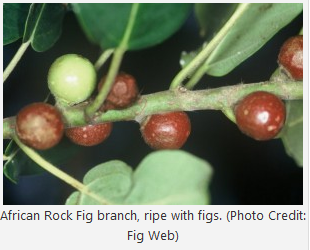Figs have been a food staple for centuries in the Middle East and Africa. For the ancient Egyptians, the fig was such an important food that as a defense, Egyptian armies would cut down the figs and vines of their enemies. Today, figs of the species Ficus carica are of global importance.
Although never commercially cultivated, a less well-known wild fig, the African rock fig (Ficus glumosa) grows throughout much of tropical Africa where the fruit is consumed in rural areas. The African rock fig is a small tree, which can grow 5 to 10 meters tall in rocky or clay soil. If the tree’s roots reach fertile soil or a water source, its height can reach 24 meters.
 The trees produce a fruit that is small, 10-14 mm in diameter, and often grow in pairs, clustered at the ends of branches among the leaves. Figs start off green and as they ripen turn to red, indicating that they are ready to pick. Figs ripen during the months of January to June and are at their sweetest when ripe. In Senegal, the African rock fig is said to be the most flavorful of the wild figs.
The trees produce a fruit that is small, 10-14 mm in diameter, and often grow in pairs, clustered at the ends of branches among the leaves. Figs start off green and as they ripen turn to red, indicating that they are ready to pick. Figs ripen during the months of January to June and are at their sweetest when ripe. In Senegal, the African rock fig is said to be the most flavorful of the wild figs.
Beyond its delicious, sweet fruit, the African rock fig provides a variety of other resources. The bark provides tannin for tanning hides and a red dye used for clothing. The bark also contains sticky white latex that has multiple uses—in Ghana it is used to trap crickets, in Uganda as chewing gum, and in the Republic of The Gambia, in West Africa, the Tenda people use the latex to affix arrowheads to shafts. The wood is can be used for firewood and charcoal. The young leaves of the fig tree are also edible and are often used as an ingredient for soups in Ghana.
Fig trees can provide a valuable wind break or natural fence because these trees can be grown on steep, rocky slopes with little water and in clay soils. As a natural fence, fig trees can not only provide shade and shelter, but they can also limit erosion and soil loss from strong winds.
The African rock fig’s medicinal value is widespread throughout Africa. The bark and fruit are used to treat sores, provide eye and dental care, and are even used in preparations to supposedly cure female sterility in Senegal.
The African rock fig is a multipurpose tree that can be propagated by seeds or seedlings and cuttings from mature trees. This wild fig is valuable to Sub-Saharan Africa for the fruit it produces, including its ability to grow on rocky slopes and in clay soil, as well as its resistance to drought. By planting these fig trees in areas with poor soil and rocky terrain, the fruit could provide a supplemental food source and income to rural communities.
Do you know of any wild versions of fruits that are edible?
Lacey Cochart is a research intern with the Nourishing the Planet project.

Danielle Nierenberg, an expert on livestock and sustainability, currently serves as Project Director of State of World 2011 for the Worldwatch Institute, a Washington, DC-based environmental think tank. Her knowledge of factory farming and its global spread and sustainable agriculture has been cited widely in the New York Times Magazine, the International Herald Tribune, the Washington Post, and
other publications.
Danielle worked for two years as a Peace Corps volunteer in the Dominican Republic. She is currently traveling across Africa looking at innovations that are working to alleviate hunger and poverty and blogging everyday at Worldwatch Institute’s Nourishing the Planet. She has a regular column with the Mail & Guardian, the Kansas City Star, and the Huffington Post and her writing was been featured in newspapers across Africa including the Cape Town Argus, the Zambia Daily Mail, Coast Week (Kenya), and other African publications. She holds an M.S. in agriculture, food, and environment from Tufts University and a B.A. in environmental policy from Monmouth College.








